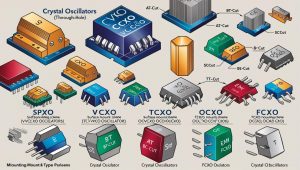The global crystal oscillator market size is on a steady upward trajectory, driven by rapid advancements in communication technologies and the increasing demand for highly stable and precise frequency control components. As the backbone of countless electronic devices, crystal oscillators are essential for timing accuracy and synchronization in everything from smartphones and satellites to networking equipment and medical devices. With the emergence of next-generation networks such as 5G, along with the proliferation of IoT, automotive electronics, and advanced computing systems, the market for crystal oscillators is expected to witness significant expansion in the coming years.
The Role of Crystal Oscillators in Modern Technology
Crystal oscillators serve as key components that generate consistent and reliable clock signals, enabling the operation of digital integrated circuits and microprocessors. These oscillators utilize the mechanical resonance of piezoelectric crystals—typically quartz—to create electrical signals with extremely precise frequencies. Their low power consumption, small size, and high accuracy make them indispensable in systems where timing precision is critical.
From RF communication devices to GPS receivers and embedded systems, the applications for crystal oscillators are vast and growing. In communication networks, especially, the need for synchronized data transmission across high-speed platforms has intensified the demand for high-frequency, low-jitter oscillators.
Communication Technologies Drive Market Growth
The evolution of communication technology is a primary catalyst in the expansion of the crystal oscillator market. With the rollout of 5G infrastructure, the requirement for high-performance frequency control devices has surged. 5G base stations, mobile devices, and network routers all rely on ultra-stable timing signals to maintain seamless data flow and reduce latency. Crystal oscillators, particularly temperature-compensated (TCXO) and oven-controlled (OCXO) variants, are being widely adopted to meet the stringent performance standards set by modern communication protocols.
Download PDF Brochure @ https://www.marketsandmarkets.com/pdfdownloadNew.asp?id=943

Moreover, the Internet of Things (IoT) is amplifying demand for compact and energy-efficient oscillators across millions of connected devices. IoT sensors, smart wearables, and home automation systems depend on crystal oscillators for precise operation while minimizing power consumption. The rising number of IoT deployments in industries such as healthcare, agriculture, logistics, and smart cities is contributing to the increasing market penetration of crystal oscillator solutions.
Technological Advancements and Innovation
Recent advancements in manufacturing techniques and material science have led to the development of more reliable and efficient crystal oscillators. Surface-mount technology (SMT) and miniaturization have allowed manufacturers to produce oscillators with higher durability and improved thermal stability in smaller packages. Additionally, innovations in MEMS (Micro-Electro-Mechanical Systems) are paving the way for hybrid oscillator solutions that combine the robustness of MEMS with the precision of quartz, offering enhanced performance for rugged and portable applications.
Companies are also investing heavily in research and development to improve frequency stability, reduce phase noise, and support a broader temperature range, making oscillators more suitable for harsh environments and mission-critical applications such as aerospace, defense, and automotive.
Regional Market Outlook
Asia-Pacific crystal oscillator market currently holds the largest share of the global crystal oscillator industry , fueled by the presence of major electronics manufacturing hubs in countries like China, Japan, South Korea, and Taiwan. The region’s rapid industrialization, growing consumer electronics demand, and expanding telecom networks contribute significantly to market growth.
North America and Europe are also witnessing increased adoption of crystal oscillators, driven by developments in defense electronics, satellite communication, and advanced computing technologies. Government investments in digital infrastructure and smart manufacturing initiatives further support regional growth.
Future Outlook
The crystal oscillator market is expected to continue expanding over the next decade, supported by ongoing advancements in communication technologies and an increasing need for synchronization and precision across all digital systems. As industries push the boundaries of connectivity, speed, and automation, the demand for highly accurate and resilient timing components will remain a cornerstone of innovation.
Manufacturers that prioritize R&D, scalability, and integration of advanced materials and design will be well-positioned to capitalize on this growth. With communication technologies evolving at a rapid pace, the global crystal oscillator market stands at the threshold of a new era, where precision and reliability are more critical than ever.
